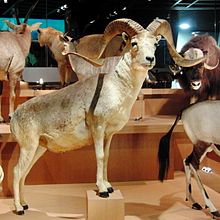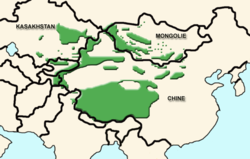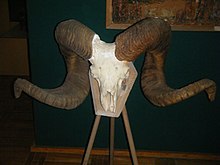Argali

As Argali or Giant Wild sheep ( Ovis ammon group) is a group of closely related species of sheep indicated. They represent their largest wild representatives. Originally, all these species were combined with Argali and the scientific name Ovis ammon .
description

The rams of the northeastern forms reach a shoulder height of 135 cm and a weight of up to 216 kg. The south-western representatives are usually a bit smaller.
The coat color of the Argalis varies. In winter fur, the basic color is brown, with dark brown, red-brown and beige tones occurring. In the summer coat, the red tones of the coat intensify. A black stripe that runs from the neck to the middle of the back is also only visible in summer. The ventral side is yellowish or gray-white. A black or brown stripe runs between the light belly and the darker flanks, but this is not always visible and is sometimes interrupted. The buttocks and tail are white. White drawings on the back occur in two forms (Altai-Argali, Gobi-Argali). The neck and the tip of the snout can also be whitish. The legs are brown on the outside like the flanks and back, sometimes a little darker; the inside of the legs is whitish. Female Argalis are usually the same color as the rams, but are a bit lighter on the cut.
The horns are longer and heavier than those of any other wild sheep. Their color is yellow-brown. In the rams of the Pamir-Argali they can be 164 cm long; in other representatives the mean horn length is 110 to 120 cm. At the base the horns have a circumference of about 40 cm. They perform up to two full turns in a spiral and then point to the side. The span is on average 75 cm, in the Pamir-Argali up to 130 cm. Together with the skull, the horns weigh up to 22 kg. The surface of the horns is ribbed, the color is gray-yellow. The fighting between the rams often results in animals with damaged or broken horn tips. The females of the Argali also have horns, but they are much shorter than those of the rams (length 30 to 45 cm). These are much thinner and more saber-shaped.
Argalis run like domestic sheep and can reach speeds of 50 km / h (rams) or 60 km / h (females).
distribution
The distribution area of the Argalis includes several mountain chains in Central Asia and extends from the Altai Mountains and southern Siberia via Mongolia , Tibet and the Tianshan region to Nepal and the Pamir Mountains .
Fossil finds from the Pleistocene indicate that Argalis were once common in the Caucasus and Iran .
Argalis live at altitudes between 300 and 5750 m. They prefer gentle inclines, only females with lambs also seek out steep slopes to protect them from enemies. Bucks are more cold tolerant than females and soar to great heights earlier in the year. Usually argalis avoid forested areas. But where cattle-keeping and hunting have displaced the argalis, they have withdrawn to alien habitats and are now forest animals, for example in parts of Kazakhstan .
Social behavior
Argalis are herd animals. Bucks and females live in separate herds. The sexually mature bucks form groups of 2 to 27 animals outside the rut , with the average herd size being four (Tianshan) or eight (Altai). Some males also live solitary.
The other herds are made up of females, young animals and not yet sexually mature rams. These herds are larger, ranging from two to 90 animals, and sometimes up to 200 individuals in the Altai. In these herds, it is not the females that dominate, but the young bucks.
Reproduction
During the rutting season, the herds of the bucks break up and their members visit the herds of females. Then each herd of females takes on one or more (maximum six) bucks. The rut takes place in winter. In Mongolia it lasts from September to October, in Altai from November to December, in Tibet from December to January.
In the first week of the rut there are fights in which the bucks determine a hierarchy. They hit the horns violently, which can be heard 400 to 800 meters away. The fighting often results in damaged horns or injured snouts. After the end of the fighting, several bucks within a herd tolerate each other, but do not tolerate too close an approach. The bucks now sniff the genitals of the females and perform the copulation. After the end of the rut, the bucks remain in the female herd for one to two months before they go their own way again.
The gestation period is 160 to 165 days. In climatically friendly locations the first lambs are born in March and April, in high mountain locations not before May / June. A single cub is usually born, but twin births do occur. Twins are rare exceptions in the Altai, Pamir and Tibet Argali; they are most common in the Tianshan Argali, where 33% of the females give birth to twins and triplets have even been observed once. In general, twin births are much rarer in inhospitable regions than at lower altitudes.
The young animals have a gray-yellow fur, the head stands out from it in dark brown. At birth, they weigh about 3 kg. The horns begin to grow between 15 and 20 days of age. At the same time, milk teeth are formed, which are only replaced by permanent teeth at the age of two. As long as young animals are suckled, the mother animals separate from the herds and seek out more rugged terrain. At one to two months old, young animals graze and are no longer suckled.
In the wild, Argalis can live to be up to 13 years old, but mostly only reach an age of four to five years.
food
The food is mainly sedges and grasses , as well as herbs. At lower altitudes, leaves are also eaten by bushes. The daily requirement for food is 16 to 18 kg.
Enemies
The main natural enemy of the Argalis is the wolf . Depending on the region, 3 to 73% of all deaths among Argalis are due to wolves. Other animals that hunt argalis are snow leopards , wolverines , lynxes and brown bears . Lambs have a larger number of predators, including the red fox and the golden eagle . Females try to defend their lambs against such enemies that cannot be dangerous to them themselves.
Even hard winters can have a hard time affecting argalis. In extremely cold and snowy years, entire populations can collapse. In 1996, half of all Argalis in Tibet died from a harsh winter.
species
Originally all representatives were grouped into one species, within which Grubb (2005) distinguished nine subspecies of the Argali. A revision of the hornbeams in 2011 raised all of them to species status. The following types are recognized today:
- Altai wild sheep or Altai Argali ( Ovis ammon (Linnaeus, 1758) ): southern Siberia and western Mongolia in the Altai and Sajan Mountains ; very large, heavy horns, neck and trunk gray-brown.
- Kazakhstan Wild Sheep or Karaganda Argali ( Ovis collium Severtzov, 1873 ): Isolated from the other species in northeastern Kazakhstan .
- Gobi wild sheep or Gobi argali ( Ovis darwini Przewalski, 1883 ): Gobi territory in Mongolia and China.
- Tibet-Argali or Great Tibetan Sheep ( Ovis hodgsonii Blyth, 1841 ): highlands of Tibet , Himalaya ; large, the horns do not form a full circle. The Altunschan or Gansu Argali of the Altun Mountains in northern Tibet is often viewed as an isolated occurrence or as an independent subspecies or species Ovis dalailamae .
- North China Wild Sheep or North Chinese Argali ( Ovis jubata Peters, 1876 ): Inner Mongolia .
- Tianshan-Argali ( Ovis karelini Severtzov, 1873 ): Tianshan north of the Naryn , Kyrgyz mountains , Tarbagatai mountains .
- Karatau wild sheep ( Ovis nigrimontana Severtzov, 1873 ): south-central Kazakhstan, Karatau region .
- Pamir-Argali , also Katschkar or Marco Polo sheep ( Ovis polii Blyth, 1841 ): Pamir (for example Taxkorgan reserve and Khunjerab national park ); medium-sized, huge horns that curl into a full circle and protrude far outwards at the tips. The differences between Marco-Polo-Argali and Tienshan-Argali are, however, weak and so both could belong to a single species. The distribution area between the Marco Polo Argalis in the Pamir Mountains and the Tienshan Argalis in the Tienshan is also continuous
- Kyzylkum wild sheep or Nuratau argali ( Ovis severtzovi Nasonov, 1914 ): northeastern Uzbekistan . The Kysylkum-Argali has long been regarded as a transition form between Argali and Urial . Based on the skull features, the species is closer to the urials. However, recent investigations of the chromosome set showed that it can be assigned to the Argali. Among other things, it has 56 chromosomes like all Argalis species examined so far.
Relationship to people
The first European to describe an Argali was Wilhelm von Rubruk , a Franciscan who toured Mongolia. The first scientific description was provided by Johann Georg Gmelin , who saw Argalis in the Altai in 1752/53, drew them and gave them the name "Argali". He borrowed this name from the Mongolian language . Carl von Linné gave the scientific name Capra ammon in 1758. The name ammon was derived from the god Amun (also called Ammon), who in the Egyptian imagination wore a ram's horn. Peter Simon Pallas later placed the Argali in the genus Ovis and named it Ovis argali . Since, according to the rules of the ICZN, the first species name assigned must apply, the Altai wild sheep today bears the scientific name Ovis ammon .
Due to trophy hunting and competition with herds of domestic animals, the Argalis have become rare or have disappeared almost everywhere. The animals have already been exterminated in northeast China, parts of Mongolia, most of southern Siberia, Kazakhstan and Uzbekistan . In the Himalayas , Inner Mongolia and in most parts of Tibet and Xinjiang are rare today. In Russia only a few still live in the Altai Mountains.
The populations of all species are declining, and the total number of argalis is likely to be less than 80,000 animals across Asia . Most likely they are still in Tajikistan , Kyrgyzstan and parts of Mongolia. The IUCN leads the Argalis in the status low endangered ( near threatened ). The Karatau Argali is considered "critically endangered", the Gobi-Argali and Kysylkum-Argali as "critically endangered" and all other species as "endangered".
literature
- Alexander K. Fedosenko, David A. Blank: Ovis ammon. In: Mammalian Species. No. 773, 2005, ISSN 0076-3519 , pp. 1-15.
- Colin P. Groves and David M. Leslie Jr .: Family Bovidae (Hollow-horned Ruminants). In: Don E. Wilson and Russell A. Mittermeier (eds.): Handbook of the Mammals of the World. Volume 2: Hooved Mammals. Lynx Edicions, Barcelona 2011, ISBN 978-84-96553-77-4 , pp. 733-739.
- Vivek Menon (Ed.): A Field Guide to Indian Mammals. Dorling Kindersley, Delhi 2003, ISBN 0-14-302998-3 .
- Ronald M. Nowak: Walker's Mammals of the World. 2 volumes. 6th edition. Johns Hopkins University Press, Baltimore MD et al. 1999, ISBN 0-8018-5789-9 .
- Stanley H. Prater: The Book of Indian Animals. 3rd edition. Bombay Natural History Society, Bombay 1971.
- CITES instruction for the border veterinary service
Individual evidence
- ^ Peter Grubb: Order Perissodactyla . In: Don E. Wilson, DeeAnn M. Reeder (Eds.): Mammal Species of the World . A Taxonomic and Geographic Reference . 3. Edition. Johns Hopkins University Press, Baltimore 2005, ISBN 0-8018-8221-4 , pp. 637-722 (pp. 707-708).
- ↑ Colin P. Groves and David M. Leslie Jr .: Family Bovidae (Hollow-horned Ruminants). In: Don E. Wilson and Russell A. Mittermeier (eds.): Handbook of the Mammals of the World. Volume 2: Hooved Mammals. Lynx Edicions, Barcelona 2011, ISBN 978-84-96553-77-4 , pp. 733-739
- ↑ Lichun Jiang, Gaochao Wang, Shuai Tan, Shu Gong, Min Yang, Quekun Peng, Rui Peng and Fangdong Zou: The complete mitochondrial genome sequence analysis of Tibetan argali (Ovis ammon hodgsoni): Implications of Tibetan argali and Gansu argali as the same subspecies. Gene 521, 2013, pp. 24-31
- ↑ George B. Schaller, Aili Kang: Status of Marco Polo sheep Ovis ammon polii in China and adjacent countries: Conservation of a Vulnerable subspecies. In: Oryx , Vol 42, No 1, 2008
- ↑ Colin Groves and Peter Grubb: Ungulate Taxonomy. Johns Hopkins University Press, 2011, pp. 1–317 (SS 108–280)
- ↑ Bunch et al .: Chromosome number of Severtzov's sheep (Ovis ammon severtzovi): G-banded karyotype comparisons within ovis. In: Journal of Heredity , 1998, PMID 9656470 , oxfordjournals.org (PDF)
- ^ IUCN website , accessed September 26, 2008.
Web links
- Short film by an Altai Argali
- Ovis ammon inthe IUCN 2013 Red List of Threatened Species . Posted by: Harris, RB & Reading, R., 2008. Retrieved January 22, 2014.


